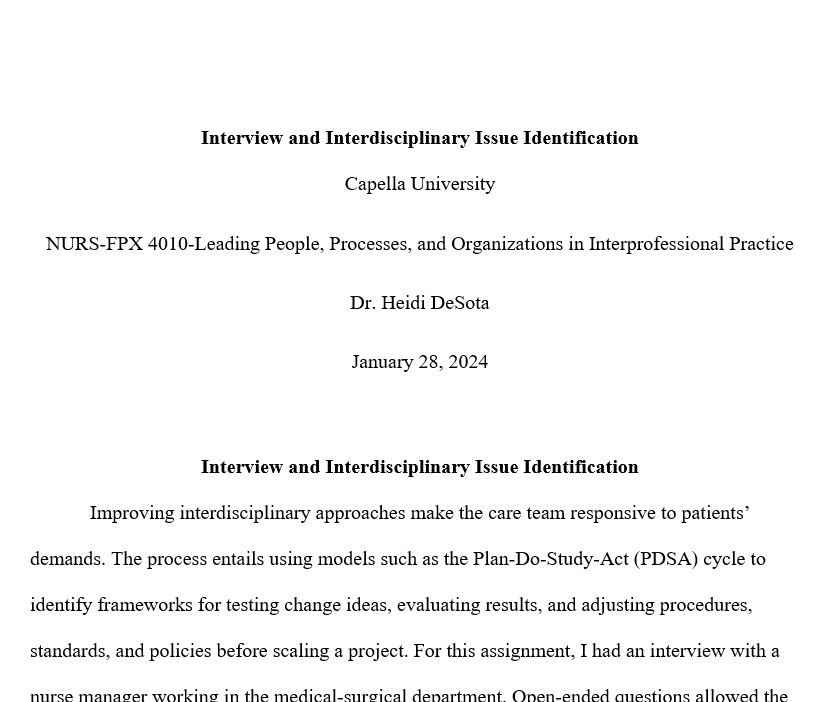Interview and Interdisciplinary Issue Identification
Capella University
NURS-FPX 4010-Leading People, Processes, and Organizations in Interprofessional Practice
Dr. Heidi DeSota
January 28, 2024
NURS-FPX4010_C_Assessment 2-1 Solution.docx
Interview and Interdisciplinary Issue Identification
Improving interdisciplinary approaches make the care team responsive to patients’ demands. The process entails using models such as the Plan-Do-Study-Act (PDSA) cycle to identify frameworks for testing change ideas, evaluating results, and adjusting procedures, standards, and policies before scaling a project. For this assignment, I had an interview with a nurse manager working in the medical-surgical department.
Open-ended questions allowed the interviewee to share details of issues in the organization, implications, and evidence-based solutions (Byrne, 2017). It was an excellent opportunity to acquire insights into the scenarios in the clinical environment and strategies necessary to optimize care outcomes. I previously worked with the interviewee where I l acquired knowledge and skills on the best ways to respond to clients’ demands.
With over 12 years of experience working in the nursing profession, the nurse manager was the right person to highlight events associated with interdisciplinary collaboration. The first-hand experiences serving in a managerial position meant that the interviewee understood policies, procedures, and standards that shape interprofessional collaboration. The nurse manager plays an active role in setting goals, implementing budgets, and aligning nursing practice with strategic priorities.
The candid conversation on interprofessional collaboration captured the barriers and enablers of consistent fulfilment of patients’ needs and expectations. The manager addressed the need for leaders to embrace qualities and traits that help create an open, honest, and transparent working environment. The leadership skills help streamline communication by breaking hierarchical barriers and power distances that jeopardize the quality of interdisciplinary collaboration.
Hussain et al. (2018) encouraged healthcare professionals to make informed decisions characterized by collective buy-in and effective sharing of suggestions on improvements necessary to achieve strategic priorities. I also asked questions about the most common issues that required interprofessional collaboration to enhance the quality and safety of patient care. The interviewee identified challenges such as low staffing levels, turnover, sepsis, and hospital-acquired infections. The issue affected the medical-surgical unit ability to make meaningful contributions to the organization financial stability.
The Issue
While the nurse manager discussed multiple issues, the one that caught my attention was the worrying rates of hospital-acquired infections. The nurse manager indicated that the medical-surgical unit was experiencing frequent surgical site infections that raised questions about the quality and safety of patient care. Patients are vulnerable to prolonged hospitalization, readmissions, additional costs, and severe complications caused by surgical site infections (Qvistgaard et al., 2019).
For the facility, the infections jeopardize brand credibility, increase operational costs, and reduce revenues. In this case, the issue undermines organization ability to achieve strategic priorities, which include sustaining competitive advantage. The frequency and severity of surgical site infections make it necessary to initiate interdisciplinary collaboration to share unique insights into evidence-based and sustainable solutions.
Change Theory and Leadership to Address the Issue
Successful outcomes depend on efforts to embrace changes and enhance collective buy-in within the medical-surgical unit. Health leaders can utilize various theories to guide the care team when identifying and implementing changes. The Plan-Do-Study-Act (PDSA) cycle is a viable option for the team to adopt systematic actions steps for addressing hospital-acquired infections (Backhouse & Ogunlayi, 2020). The framework makes everyone familiar with the need for safer, efficient, equitable, and patient-centered services (McNicholas et al., 2019). Thus, leaders initiate the first step by communicating the purpose, the problem, and intended outcomes.
The transformational leader is the right option to communicate a shared vision and direction for achieving short and long-term results (Varagona et al., 2017). The transformational leader clarifies responsibilities, accountabilities, and targets necessary for achieving the best results. The leader share details of the identified quality indicator, which is surgical site infections. Awareness about the issue facilitates collaborative discussions about predicted outcomes, lessons learned, and the aspects that enable the team to achieve the intended outcomes. Further, the transformational leader clarifies measures and procedures to prevent surgical site infections.
Collaboration Strategies
The interdisciplinary team has physicians, pharmacists, therapists, nurses, clinical assistants, and the nurse manager. The identified strategy is interprofessional safety rounds to enhance collective awareness about weaknesses and improvements necessary to maintain a safe clinical environment. One collaboration strategy is maintaining effective information flow through horizontal communication (Hussain et al., 2018).
Leaders coordinate with members of the care team to make informed conclusions about issues associated with surgical site infections. Collaboration also requires an open, honest, and transparent environment. The considerations promote mutual interests with everyone dedicated to sharing suggestions on the best ways for identifying and intercepting risks associated with hospital-acquired infections. Clarity of roles and responsibility is another priority that makes everyone aware of their contributions towards maintaining a functional interdisciplinary team.
References
Backhouse, A., & Ogunlayi, F. (2020). Quality improvement into practice. BMJ: British Medical Journal (Online), 368.
Byrne, D. (2017). Data collection: How do I collect data using interviews? Project Planner, 1–11.
Hussain, S., Lei, S., Akram, T., Haider, M., Hussain, S., & Ali, M. (2018). Kurt Lewin’s change model: A critical review of the role of leadership and employee involvement in organizational change. Journal of Innovation & Knowledge, 3(3), 123–127. https://doi.org/10.1016/j.jik.2016.07.002
McNicholas, C., Lennox, L., Woodcock, T., Bell, D., & Reed, J. E. (2019). Evolving quality improvement support strategies to improve plan–do–study–act cycle fidelity: A retrospective mixed-methods study. BMJ Quality & Safety, 28(5), 356–365. https://pubmed.ncbi.nlm.nih.gov/30886118/
Qvistgaard, M., Lovebo, J., & Almerud-Österberg, S. (2019). Intraoperative prevention of Surgical Site Infections as experienced by operating room nurses. International Journal of Qualitative Studies on Health and Well-being, 14(1), 1-8. https://www.tandfonline.com/doi/pdf/10.1080/17482631.2019.1632109



